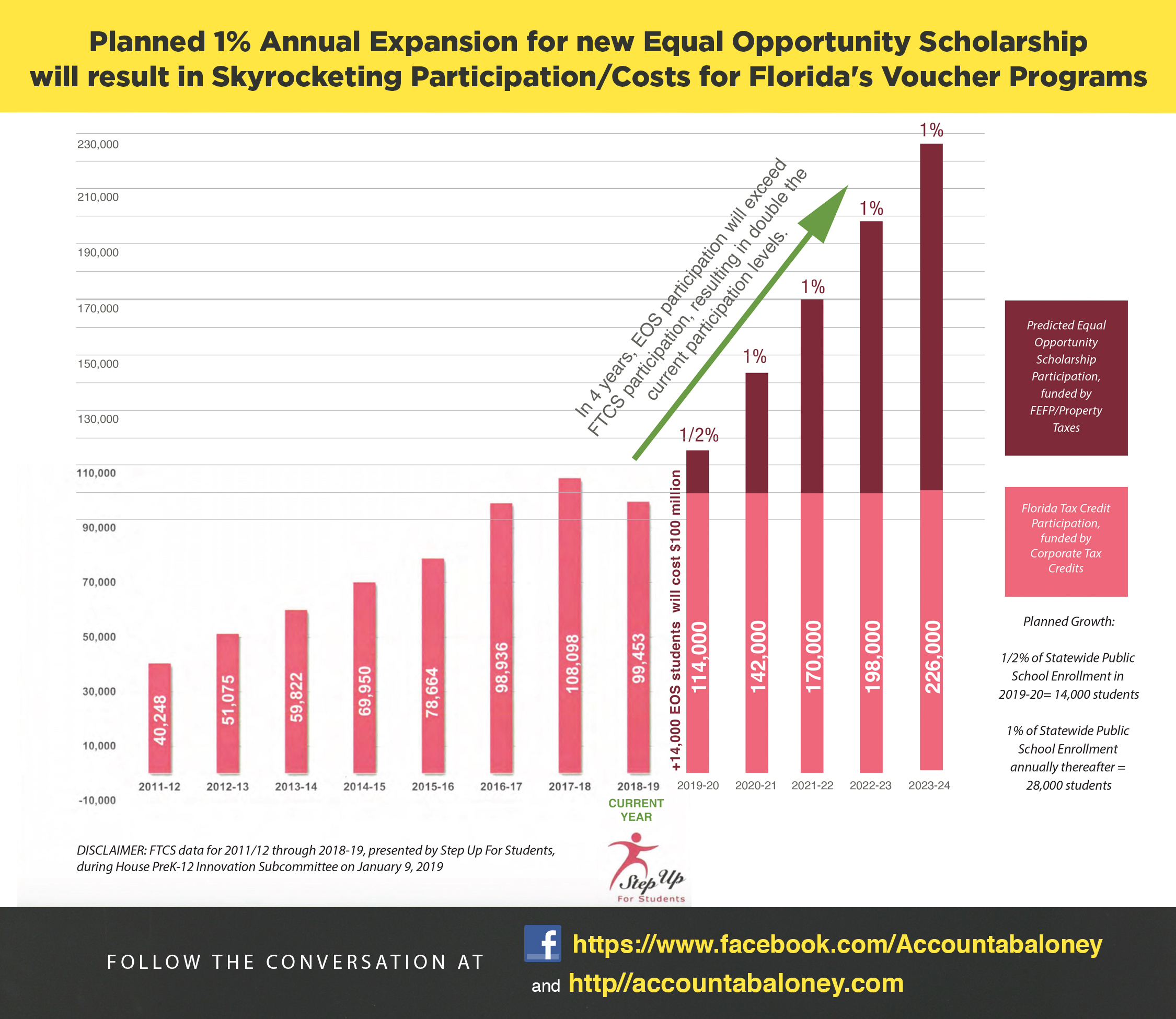Guess Whose Property Taxes are Going to Pay for DeSantis’ New Private School Voucher?
Spoiler Alert: YOURS.
On February 15, 2019, Governor DeSantis visited private religious schools in Orlando and Miami to announce his plan to create a new “Equal Opportunity Scholarship” voucher, designed to “complement” the current Tax Credit Scholarship, which has been struggling to find enough corporate donors to participate in it’s tax diversion voucher scheme. Currently approximately 100,000 low income students use the tax diverted vouchers to attend private, mostly religious, schools. The Governor’s newly proposed voucher would provide additional vouchers to the 14,000 students that the Governor claims are on a waiting list, allowing those students to take public funds directly to those private schools. This time, however, much of the funding will come directly from your pocket.
During the press event, Governor DeSantis suggested that funding for the Equal Opportunity vouchers would come from the state’s general revenue fund, like current funding for McKay and Gardiner vouchers. He also called on the legislature to “step up for these students” and pass a really strong bill for him to sign, suggesting education committees would be tasked with creating details for the new voucher program. Details released in a press release and, later, in the Governor’s Budget Recommendation Implementing Bill tell a different story. The funding source will be your property taxes and the legislature will be asked to rubber stamp a bill created in the executive branch.
Per the press release:
Funding for the scholarship program is contained within the Florida Education Finance Program (FEFP). The scholarship award amount would be a slight discount of the district average per-student funding in the FEFP, allowing funding to follow the student. The maximum number of students eligible to receive a scholarship is equivalent to half of one percent of statewide public school enrollment for the first year, providing opportunities for approximately 14,000 students. Each year thereafter, the number of eligible students increases by an additional one percent of statewide public school enrollment.
Clarification. The FEFP is the per-pupil funding formula which is the primary source of public school classroom funding. It is composed of a Base Student Allocation, which the districts can spend in a flexible way for salaries, instruction materials, etc, and a series of specific funding allocations defined by the state (like transportation, special education, etc). When the State increases funding in a specific allocation (like it did last year with School Safety funding), it can celebrate “record per pupil education funding” while adding little extra funding (47 cents last year) to the Base Student Allocation, leaving districts struggling to fund their payroll. Districts are required to contribute a percentage of the FEFP, called the Required Local Effort (RLE), via property tax millage. Wealthier counties are asked to contribute a larger percentage (up to 90%) to the FEFP. The counties that contribute 90% RLE are Collier, Franklin, Monroe, Sarasota, Sumter and Walton. Other education funding, like Gardiner voucher spending, comes directly from the State’s General Revenue, which, in Florida, is funded primarily through sales tax.
By placing the new voucher’s funding source in the FEFP, the Governor will require local communities to levy taxes to pay for his new voucher program AND he will be able to, simultaneously, celebrate an increase in per pupil funding (despite the money going directly to voucher schools).
During the press conferences, the Governor announced, this year, the new voucher funding would be $90-100 million, enough to fund the 14,000 students reported to be on a waiting list for these private schools. He, also, admitted he has ambitions to expand the program in the future. What he DIDN’T say was his Implementation Bill calls for an automatic increase in enrollment equivalent to 1% of the entire student population in Florida (approximately 28,000 students) to the program every single year. The funding required for the 28,000 extra vouchers would be approximately $200 million.
Anyone who thinks a 1% increase is a slow and gradual increase should consider this: the Florida Tax Credit Scholarship (FTCS), which this new scholarship is meant to “complement,” was established in 2001 and, after 18 years, serves just 100,000 students. With an annual increase of 1% of the entire Florida student population, or 28,000 students, the Equal Opportunity scholarship will exceed FTCS participation in less than 4 years. The costs will skyrocket.
We used FTCS data, presented by Step Up For Students, during the House PreK-12 Innovation Subcommittee on January 9, 2019, to demonstrate the effect of this annual 1% expansion on total voucher participation (FTCS + Equal Opportunity Scholarship).

By adding 14,000 students ($100 million) in 2019-20, followed by an additional 28,000 students ($200 million) each year, the Equal Opportunity Scholarship/Voucher, in its first 4 years, may cost Florida taxpayers $1.6 BILLION! Here is the math:
$100 million (in 2019-20) + $300 million (in 2020-21) + $500 million (in 2021-22) + $700 million (in 2022-23) = $1.6 BILLION spent on DeSantis’ new Equal Opportunity Voucher Program in the next 4 years.
That is A LOT of property tax revenue! Either your property taxes are going to go up or the funding of public schools is going to go down (or, perhaps, a little of both).
By hiding voucher funding in the FEFP, ever increasing voucher funding could lead to “record public education spending” while literally defunding traditional public schools. Tax payers may barely recognize they are funding the demise of public education which, it appears, is the plan.
[DeSantis’ budget also includes a $6,239,520 appropriation, from General Revenue, for “Equal Opportunity Scholarship Accounts – Administative Expenses” which seems like a lot of money for a program meant to differ from an existing program primarily by it’s finding source.]
